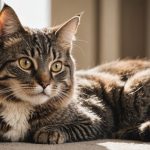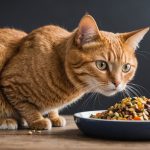Understanding Hyperthyroidism in Cats
Hyperthyroidism in cats is a prevalent condition, especially in older felines, caused by an overproduction of thyroid hormones. This hormonal imbalance can profoundly affect a cat’s health, leading to increased metabolism and various other symptoms. Typically, hyperthyroidism can trigger notable changes, such as weight loss despite a good appetite, increased thirst and urination, and noticeable behavioural shifts like increased activity or restlessness.
Recognising symptoms early is crucial for effective management. You may notice your cat losing weight rapidly, displaying a sleek coat, or perhaps even becoming unusually vocal. These symptoms should ring alarms for any attentive pet owner. Veterinarians can confirm a diagnosis through a series of tests, often involving blood samples that measure the hormone levels in your cat’s body.
Avez-vous vu cela : Crafting the Purrfect Bedtime Routine: Tips for a Relaxing Night for Your Cat
Diagnosis of this condition is essential for ensuring the well-being of your feline companion. With early detection and appropriate treatment, such as medication or diet adjustments, most cats can live comfortable, healthy lives. Regular vet check-ups are indispensable, as they facilitate early detection and help tailor a management programme suitable for your cat’s unique needs. Prioritising veterinary care enhances your pet’s quality of life and mitigates potential complications associated with hyperthyroidism.
Nutritional Needs for Hyperthyroid Cats
Caring for a cat with hyperthyroidism involves understanding their specific nutritional needs and ensuring they receive the right balance of required nutrients. This condition accelerates metabolism, increasing their demand for certain dietary elements that support overall health.
A lire en complément : Empowering Your Cat: Strategies to Alleviate Anxiety and Address Sensory Processing Challenges in Daily Life
Essential Nutrients
Hyperthyroid cats require a diet rich in essential nutrients such as iodine, taurine, and omega-3 fatty acids. These elements are crucial in managing thyroid function and promoting heart health. Minerals such as calcium and phosphorus also play a significant role by aiding in bone health, which is particularly important due to increased excretion rates observed in hyperthyroidism.
Macronutrients vs Micronutrients
A proper dietary balance between macronutrients and micronutrients is vital. Protein should be moderately high to prevent muscle wasting, which often occurs due to the cat’s heightened metabolic state. Carbohydrates should be limited to prevent unnecessary spikes in energy levels and to maintain stable blood glucose. Fats, as a source of condensed energy, should be carefully monitored to avoid weight loss.
Importance of Diet Composition
Balancing dietary fiber contributes significantly to a hyperthyroid cat’s well-being. It supports digestive health and helps regulate bowel movements, often erratic in these felines. A well-formulated diet ensures these cats receive optimum nutrition while mitigating symptoms associated with their condition.
Recommended Foods for Hyperthyroid Cats
Choosing the right diet for a hyperthyroid cat is crucial in managing their health. There are two main dietary approaches: commercial diets and homemade diets.
Commercial Diet Options
Commercial diets specifically formulated for hyperthyroid cats can be beneficial due to their balanced nutrients designed to support feline thyroid health. These diets often contain controlled levels of iodine, as excessive iodine has been linked to aggravating thyroid conditions in cats. Brands often recommended by veterinarians prioritise ingredients that support metabolism and overall health. Commercial options make managing your cat’s diet convenient while ensuring they receive the necessary nutrients for their condition.
Homemade Diet Ideas
For those preferring more control over their cat’s diet, homemade meals can be a suitable alternative. Creating a homemade diet involves careful planning to ensure dietary balance. Key ingredients include high-quality protein sources, like chicken and fish, and an appropriate mix of cat-friendly vegetables. Consulting with a veterinary nutritionist can help in crafting recipes that fulfill your hyperthyroid cat’s nutritional needs while avoiding nutrients that could trigger symptoms.
Foods to Avoid
Certain foods can exacerbate hyperthyroid symptoms. It’s advisable to refrain from feeding your cat excessive fish oils or iodine-rich foods. Foods containing artificial additives and excessive carbohydrates might also worsen their health. Regularly reviewing and adjusting your cat’s diet will help in managing their hyperthyroid condition effectively.
Portion Sizes and Caloric Intake
Ensuring appropriate portion sizes is crucial for managing your hyperthyroid cat’s health. Determining these sizes involves considering your cat’s specific weight and energy needs. Begin by assessing your cat’s current weight and overall health, which aids in calculating their daily caloric intake. The caloric needs might vary, depending upon your cat’s activity level and severity of hyperthyroidism.
For hyperthyroid cats, it’s often recommended to provide smaller, more frequent meals to help regulate their energy levels and nutritional absorption. Consult your veterinarian to tailor feeding guidelines that cater precisely to your cat’s unique requirements. Factors like age, metabolic rate, and existing medical conditions should be regarded when devising this feeding plan.
Feeding guidelines usually underline the frequency and timing of meals. A schedule offering meals at consistent times can stabilise your cat’s condition, benefiting their metabolism and digestion. Depending on individual needs, you might opt for feeding your cat two to four times a day. Additionally, monitoring your cat’s response to these adjustments will be essential, ensuring their caloric intake suits their fluctuating health demands.
Managing Your Cat’s Energy Levels
A balanced approach to energy management is vital for your cat’s well-being and happiness. Cats, like humans, have unique energy requirements, which can change due to various factors such as age, health, and dietary needs.
Understanding Energy Needs
Every cat has its own activity levels, influencing their daily routines. Cats naturally fluctuate between bursts of energy and restful periods. Recognising these patterns helps ensure their energy needs are met. A critical factor affecting energy levels is hyperthyroidism, a common disorder in older cats, causing increased activity and potential weight loss. Regular vet visits can help manage such conditions.
Tailoring Activity Levels
Adjusting your cat’s playtime and activity is essential for maintaining a healthy weight and energy balance. Incorporate varied and engaging play activities tailored to your cat’s preferences. Use toys that stimulate their hunting instincts, like feather wands or laser pointers, to keep them entertained and active. Organization of playtime in short, frequent sessions assists in managing your cat’s energy efficiently.
Recognizing Behavioral Changes
It’s important to monitor for any changes in your cat’s behavior, as these can indicate shifts in their energy or health status. Behavioral tips include observing for signs of lethargy, restlessness, or unusual sleeping patterns. Any changes could require adjustments to diet, activity levels, or consultation with a veterinarian to address underlying health issues.
Veterinary Guidance and Support
For pet owners, veterinary advice is crucial in ensuring the health and well-being of furry companions. Consulting a veterinarian is essential for creating a personalized health plan tailored to the specific needs of your pet. This step is pivotal in maintaining the overall health and happiness of your beloved animal.
Regular health check-ups play a significant role in monitoring thyroid levels and detecting any abnormalities early. These check-ups are not just routine; they are preventive measures that can identify potential health issues before they become serious. Veterinary professionals possess the expertise to interpret test results and guide pet owners in taking appropriate actions.
Sometimes, understanding and implementing necessary treatments or medications involves more than just administering pills. Professional support includes educating pet owners about possible side effects, correct dosages, and optimal timings for administering treatment. This knowledge ensures the pet receives the best care possible.
In addition to traditional treatments, veterinarians might suggest complementary therapies or lifestyle changes to improve your pet’s health. Their professional support provides a comprehensive approach to managing complex medical conditions. Engaging with veterinary guidance helps create a nurturing environment where pets can thrive, ensuring that their health is consistently monitored and well-managed.
Creating a Feeding Schedule
A well-structured feeding schedule is essential for maintaining a balanced diet for your pet. Establishing a daily routine ensures they receive meals consistently and reduces the chance of overfeeding.
Developing a Daily Routine
Begin by selecting specific times for meals, as consistent meal timing helps your pet’s digestion and metabolism. Morning and evening usually work best. Observe how your pet responds to these timings and adjust if necessary.
Balancing Meals and Treats
Integrating treats into your pet’s diet without compromising their nutritional goals requires careful consideration. Treats should not exceed 10% of their daily caloric intake. This prevents excessive calorie consumption while still allowing for occasional indulgences.
Adjusting Schedules as Needed
Life changes, and so should your pet’s feeding schedule. Adjust the timing and portions of meals as needed, especially if there’s a change in health or activity levels. This keeps their diet aligned with their current lifestyle and nutritional needs. Regularly reevaluate the schedule to ensure it remains effective for your pet’s well-being.
Setting a feeding schedule tailored to your pet fosters a healthy diet, adding structure to their day and maintaining their overall health.
Recipes for Hyperthyroid Cats
When caring for a cat with hyperthyroid issues, crafting nutritional balance in meals is crucial. Providing quick and easy cat recipes ensures that your pet receives the essential nutrients without stress.
Easy meals can be made at home by using ingredients that your cat loves, while also keeping their health in mind. Opt for recipes that incorporate high-quality protein sources like chicken or fish. This approach not only satisfies your feline’s taste buds but also supports their overall health.
Balancing flavors and nutrients is key. For instance, blending cooked chicken with steamed carrots and rice provides a wholesome meal. Add a little fish oil for a shiny coat and promote digestion. It’s essential to complement these protein-rich recipes with vitamins like taurine to prevent deficiencies.
Appealing meals for hyperthyroid cats are not only beneficial but should also be palatable. Present the food in small, soft portions, making it easier for your cat to consume. Introduce new recipes gradually, ensuring your cat’s comfort and acceptance of the meal.
By focusing on nutritional balance while keeping the meals easy and quick to prepare, you can efficiently manage your hyperthyroid cat’s dietary needs.
Monitoring Progress and Adjustments
Tracking progress in your dietary journey can be both rewarding and insightful. Progress tracking is crucial as it helps you understand the changes in weight and energy levels over time. Start by setting clear goals and using tools like journals or apps to log daily meals and exercise routines. Regular monitoring allows you to see patterns and adjust your strategy as needed.
When evaluating outcomes, consider dietary adjustments. If weight loss or energy levels are not aligning with your expectations, minor tweaks could make a significant difference. For example, adding more protein can boost energy or swapping processed snacks for healthier options may improve overall health.
A practical way to ensure successful progress tracking is by maintaining a journal. This isn’t just about calorie counting; it’s a comprehensive health tracking strategy. Document how certain foods make you feel, your motivation levels, and any physical changes. Journals provide valuable insights which may not be immediately obvious, guiding more informed decisions and personalised adjustments to your diet.
Ultimately, being in tune with your body’s responses and making necessary adjustments fosters a sustainable momentum towards your health goals.










